Bergen-Belsen concentration camp
| Bergen-Belsen | |
|---|---|
| Concentration camp | |
|
Memorial stone at the entrance to the historical camp area | |
 Location of Bergen-Belsen in Lower Saxony | |
| Coordinates | 52°45′28″N 9°54′28″E / 52.75778°N 9.90778°ECoordinates: 52°45′28″N 9°54′28″E / 52.75778°N 9.90778°E |
| Location | Lower Saxony, Northern Germany |
| Operated by | German Army, later Schutzstaffel (SS) |
| Commandant |
|
| Original use | Prisoner of war camp, later civilian internment camp |
| Operational | 1940–1945 |
| Inmates | Jews, Poles, Soviets, Dutch, Czechs, Germans, Austrians |
| Killed | unknown (estimated at 50,000 or more in the concentration camp alone) |
| Liberated by | United Kingdom and Canada, April 15, 1945 |
| Website | Bergen-Belsen Concentration Camp Memorial Site |
Bergen-Belsen [ˈbɛʁɡn̩.bɛlsn̩], or Belsen, was a Nazi concentration camp in what is today Lower Saxony in northern Germany, southwest of the town of Bergen near Celle. Originally established as a prisoner of war camp,[1] in 1943, parts of it became a concentration camp. Initially this was an "exchange camp", where Jewish hostages were held with the intention of exchanging them for German prisoners of war held overseas.[2] The camp was later expanded to accommodate Jews from other concentration camps.
After 1945 the name was applied to the displaced persons camp established nearby, but it is most commonly associated with the concentration camp. From 1941 to 1945, almost 20,000 Soviet prisoners of war and a further 50,000 inmates died there.[3] Overcrowding, lack of food and poor sanitary conditions caused outbreaks of typhus, tuberculosis, typhoid fever, and dysentery, leading to the deaths of more than 35,000 people in the first few months of 1945, shortly before and after the liberation.
The camp was liberated on April 15, 1945, by the British 11th Armoured Division.[4] The soldiers discovered approximately 60,000 prisoners inside, most of them half-starved and seriously ill,[5] and another 13,000 corpses lying around the camp unburied.[4] The horrors of the camp, documented on film and in pictures, made the name "Belsen" emblematic of Nazi crimes in general for public opinion in many countries in the immediate post-1945 period. Today, there is a memorial with an exhibition hall at the site.
Operation
Prisoner of war camp
In 1935 the Wehrmacht began to build a large military complex close to the village of Belsen, a part of the town of Bergen, in what was then the Province of Hanover.[1] This became the largest military training area in Germany of the time and was used for armoured vehicle training.[1] The barracks were finished in 1937. The camp has been in continuous operation since then and is today known as Bergen-Hohne Training Area. It is used by the NATO armed forces.
The workers who constructed the original buildings were housed in camps near Fallingbostel and Bergen, the latter being the so-called Bergen-Belsen Army Construction Camp.[1] Once the military complex was completed in 1938/39, the workers' camp fell into disuse. However, after the German invasion of Poland in September 1939, the Wehrmacht began using the huts as a prisoner of war (POW) camp.
The camp of huts near Fallingbostel became known as Stalag XI-B and was to become one of the Wehrmacht's largest POW camps, holding up to 95,000 prisoners from various countries.[6] In June 1940, Belgian and French POWs were housed in the former Bergen-Belsen construction workers’ camp. This installation was significantly expanded from June 1941, once Germany prepared to invade the Soviet Union, becoming an independent camp known as Stalag XI-C (311). It was intended to hold up to 20,000 Soviet POWs and was one of three such camps in the area. The others were at Oerbke (Stalag XI-D (321)) and Wietzendorf (Stalag X-D (310)). By the end of March 1942, some 41,000 Soviet POWs had died in these three camps of starvation, exhaustion, and disease. By the end of the war, the total number of dead had increased to 50,000.[6] When the POW camp in Bergen ceased operation in early 1945, as the Wehrmacht handed it over to the SS, the cemetery contained over 19,500 dead Soviet prisoners.
In the summer of 1943, Stalag XI-C (311) was dissolved and Bergen-Belsen became a branch camp of Stalag XI-B. It served as the hospital for all Soviet POWs in the region until January 1945. Other inmates/patients were Italian military internees from August 1944 and, following the suppression of the Warsaw Uprising in October 1944, around 1,000 members of the Polish Home Army were imprisoned in a separate section of the POW camp.[6]

Concentration camp
In April 1943, a part of the Bergen-Belsen camp was taken over by the SS Economic-Administration Main Office (SS Wirtschafts-Verwaltungshauptamt; WVHA). It thus became part of the concentration camp system, run by the SS Schutzstaffel but it was a special case.[7] Having initially been designated a Zivilinterniertenlager ("civilian internment camp"), in June 1943 it was redesignated Aufenthaltslager ("holding camp"), since the Geneva Conventions stipulated that the former type of facility must be open to inspection by international committees.[8] This "holding camp" or "exchange camp" was for Jews who were intended to be exchanged for German civilians interned in other countries, or for hard currency.[9] The SS divided this camp into subsections for individual groups (the "Hungarian camp", the "special camp" for Polish Jews, the "neutrals camp" for citizens of neutral countries and the "Star camp" for Dutch Jews). Between the summer of 1943 and December 1944 at least 14,600 Jews, including 2,750 children and minors were transported to the Bergen-Belsen "holding" or exchange camp.[10]:160 Inmates were made to work, many of them in the "shoe commando" which salvaged usable pieces of leather from shoes collected and brought to the camp from all over Germany and occupied Europe. In general the prisoners of this part of the camp were treated less harshly than some other classes of Bergen-Belsen prisoner until fairly late in the war, due to their perceived potential exchange value.[9] However, only around 2,560 Jewish prisoners were ever actually released from Bergen-Belsen and allowed to leave Germany.[9]
In March 1944, part of the camp was redesignated as an Erholungslager ("recovery camp"),[11] where prisoners too sick to work were brought from other concentration camps. Supposedly, they were in Belsen to recover and then to return to their original camps, and to resume work; but many of them died in Belsen of disease, starvation, exhaustion and lack of medical attention.[12]
In August 1944, a new section was created and this became the so-called "women's camp". By November 1944 this camp received around 9,000 women and young girls. Most of those who were able to work stayed only for a short while and were then sent on to other concentration camps or slave-labour camps. The first women interned there were Poles, arrested after the failed Warsaw Uprising. Others were Jewish women from Poland or Hungary, transferred from Auschwitz.[12] Among those who never left Bergen-Belsen were Margot and Anne Frank, who died there in February or March 1945.[13]
More prisoners
In December 1944 SS-Hauptsturmführer Josef Kramer, previously at Auschwitz-Birkenau, became the new camp commandant, replacing SS-Hauptsturmführer Adolf Haas, who had been in post since the spring of 1943.[7] In January 1945, the SS took over the POW hospital and increased the size of Bergen-Belsen. As eastern concentration camps were evacuated before the advance of the Red Army, at least 85,000 people were transported in cattle cars or marched to Bergen-Belsen.[14] Before that the number of prisoners at Belsen had been much smaller. In July 1944 there were 7,300, by December 1944 the number had increased to 15,000, and by February 1945 it had risen to 22,000. However, it then soared to around 60,000 by April 15, 1945.[7] This overcrowding led to a vast increase in deaths from disease: particularly typhus, as well as tuberculosis, typhoid fever, dysentery and malnutrition in a camp originally designed to hold about 10,000 inmates. At this point also, the special status of the exchange prisoners no longer applied. All inmates were subject to starvation and epidemics.[14]
Außenlager (satellite camps)
Bergen-Belsen concentration camp had three satellite camps. These were at regional armament works. Around 2,000 female concentration camp prisoners were forced to work there. Those who were too weak or sick to continue with their work were brought to Bergen-Belsen.[10]:204–205
Außenlager Bomlitz-Benefeld at Bomlitz near Fallingbostel was in use from September 3 to October 15, 1944. It was located at the facility of Eibia GmbH, a gunpowder works. Around 600 female Polish Jews were used for construction and production work.[10]:204
Außenlager Hambühren-Ovelgönne (Lager III, Waldeslust) at Hambühren south of Winsen was in use from August 23, 1944 to February 4, 1945. It was an abandoned potash mine, now intended as an underground production site for Bremen plane manufacturer Focke-Wulf. Around 400 prisoners, mostly female Polish or Hungarian Jews, were forced to prepare the facility and to help lay train tracks to it. This was done for the company Hochtief.[10]:204
Außenlager Unterlüß-Altensothrieth (Tannenberglager) east of Bergen was in use from late August 1944 to April 13, 1945. It was located at Unterlüß, where the Rheinmetall-Borsig AG had a large test site. Up to 900 female Polish, Hungarian, Romanian, Yugoslavian and Czech Jews had to clear forest, do construction work or work in munitions production.[10]:204
Prisoners were guarded by SS staff and received no wages for their work. The companies instead reimbursed the SS for the labour supplied. Wage taxes were also levied by local authorities.[10]:204–205
Treatment of prisoners and deaths in the camp
Current estimates put the number of prisoners who passed through the concentration camp during its period of operation from 1943 to 1945 at around 120,000. Due to the destruction of the camp's files by the SS, not even half of them, around 55,000, are known by name.[10]:269 As mentioned above, treatment of prisoners by the SS varied between individual sections of the camp, with the inmates of the exchange camp generally being better treated than other prisoners, at least initially. However, in October 1943 the SS selected 1,800 men and women from the Sonderlager ("special camp"), Jews from Poland who held passports from Latin American countries. Since the governments of these nations mostly refused to honour the passports, these people had lost their value to the regime. Under the pretext of sending them to a fictitious "Lager Bergau", the SS had them transported to Auschwitz-Birkenau, where they were sent directly to the gas chambers and killed. In February and May 1944 another 350 prisoners from the "special camp" were sent to Auschwitz. Thus, out of the total of 14,600 prisoners in the exchange camp, at least 3,550 died: more than 1,400 of them at Belsen, and around 2,150 at Auschwitz.[10]:187
In the Männerlager (the male section of the "recovery camp"), inmates suffered even more from lack of care, malnourishment, disease and mistreatment by the guards. Thousands of them died. In the summer of 1944, at least 200 men were killed by orders of the SS by being injected with phenol.[10]:196
There were no gas chambers at Bergen-Belsen, since the mass killings took place in the camps further east. Nevertheless, current estimates put the number of deaths at Belsen at more than 50,000 Jews, Czechs, Poles, anti-Nazi Christians, homosexuals, and Roma and Sinti (Gypsies).[7] Among them was Czech painter and writer Josef Čapek (estimated to be in April 1945).
The rate at which inmates died at Belsen accelerated notably after the mass transport of prisoners from other camps began in December 1944. From 1943 to the end of 1944 around 3,100 died. From January to mid-April 1945 this rose to around 35,000. Another 14,000 died after liberation between April 15 and the end of June 1945 (see below).[10]:233
| Deaths at Bergen-Belsen concentration camp December 1944 to April 15, 1945[10]:232–233 | ||
|---|---|---|
| December 1944 | at least 360 | |
| January 1945 | around 1,200 | |
| February 1945 | around 6,400 | |
| March 1945 | at least 18,168 | |
| April 1945 | around 10,000 | |
After the war, there were allegations that the camp (or possibly a section of it), was "of a privileged nature", compared to others. A lawsuit filed by the Jewish community in Thessaloniki against 55 alleged collaborators claims that 53 of them were sent to Bergen-Belsen "as a special favor" granted by the Germans.[15]
Liberation
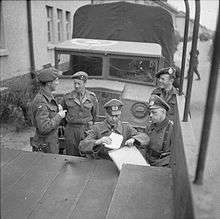
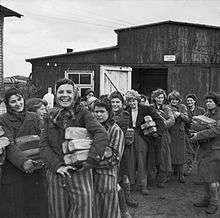

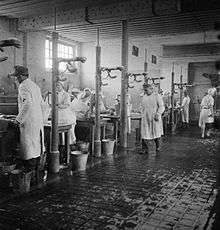


When the British and Canadians advanced on Bergen-Belsen in 1945, the German army negotiated a truce and exclusion zone around the camp to prevent the spread of typhus.[16] On April 11, 1945 Heinrich Himmler (the Reichsführer SS) agreed to have the camp handed over without a fight. SS guards ordered prisoners to bury some of the dead. The next day, Wehrmacht representatives approached the British and were brought to VIII Corps. At around 1 a.m. on April 13, an agreement was signed, designating an area of 48 square kilometers (19 square miles) around the camp as a neutral zone. Most of the SS were allowed to leave. Only a small number of SS men and women, including the camp commandant Kramer, remained to "uphold order inside the camp". The outside was guarded by Hungarian and regular German troops. Due to heavy fighting near Winsen and Walle, the British were unable to reach Bergen-Belsen on April 14, as originally planned. The camp was liberated on the afternoon of April 15, 1945.[10]:253 The first two to reach the camp were a British Special Air Service officer, Lieutenant John Randall, and his jeep driver, who were on a reconnaissance mission and discovered the camp by chance.[17]
When British and Canadian troops finally entered they found over 13,000 unburied bodies and (including the satellite camps) around 60,000 inmates, most acutely sick and starving. The prisoners had been without food or water for days before the Allied arrival, partially due to allied bombing. Immediately before and after liberation, prisoners were dying at around 500 per day, mostly from typhus.[18] The scenes that greeted British troops were described by the BBC's Richard Dimbleby, who accompanied them:
| “ | ...Here over an acre of ground lay dead and dying people. You could not see which was which... The living lay with their heads against the corpses and around them moved the awful, ghostly procession of emaciated, aimless people, with nothing to do and with no hope of life, unable to move out of your way, unable to look at the terrible sights around them ... Babies had been born here, tiny wizened things that could not live ... A mother, driven mad, screamed at a British sentry to give her milk for her child, and thrust the tiny mite into his arms, then ran off, crying terribly. He opened the bundle and found the baby had been dead for days.
This day at Belsen was the most horrible of my life.[19] |
” |
Initially lacking sufficient manpower, the British allowed the Hungarians to remain in charge and only commandant Kramer was arrested. Subsequently SS and Hungarian guards shot and killed some of the starving prisoners who were trying to get their hands on food supplies from the store houses.[10] The British started to provide emergency medical care, clothing and food. Immediately following the liberation, revenge killings took place in the satellite camp the SS had created in the area of the army barracks that later became Hohne-Camp. Around 15,000 prisoners from Mittelbau-Dora had been relocated there in early April. These prisoners were in much better physical condition than most of the others. Some of these men turned on those who had been their overseers at Mittelbau. About 170 of these "Kapos" were killed on April 15, 1945.[20]:62 On April 20, four German fighter planes attacked the camp, damaging the water supply and killing three British medical orderlies.[10]:261
Over the next days the surviving prisoners were deloused and moved to a nearby German Panzer army camp, which became the Bergen-Belsen DP (displaced persons) camp. Over a period of four weeks, almost 29,000 of the survivors were moved there. Before the handover, the SS had managed to destroy the camp's administrative files, thereby eradicating most written evidence.[21]
The British forced the former SS camp personnel to help bury the thousands of dead bodies in mass graves.[21] Some civil servants from Celle and Landkreis Celle were brought to Belsen and confronted with the crimes committed on their doorstep.[10]:262 Military photographers and cameramen of "No. 5 Army Film and Photographic Unit" documented the conditions in the camp and the measures of the British Army to ameliorate them. Many of the pictures they took and the films they made from April 15 to June 9, 1945 were published or shown abroad. Today, the originals are in the Imperial War Museum. These documents had a lasting impact on the international perception and memory of Nazi concentration camps to this day.[10]:243[21] According to Habbo Knoch, head of the institution that runs the memorial today: "Bergen-Belsen [...] became a synonym world-wide for German crimes committed during the time of Nazi rule."[10]:9
Bergen-Belsen concentration camp was then burned to the ground by flamethrowing "Bren gun" carriers and Churchill Crocodile tanks because of the typhus epidemic and louse infestation.[22] As the concentration camp ceased to exist at this point, the name Belsen after this time refers to events at the Bergen-Belsen DP camp.[10]:265
In spite of massive efforts to help the survivors with food and medical treatment, led by Brigadier Glyn Hughes, Deputy Director of Medical Services of 2nd Army, about another 9,000 died in April, and by the end of June 1945 another 4,000 had died. (After liberation 13,994 people died.)[10]:305
Two specialist teams were dispatched from Britain to deal with the feeding problem. The first, led by Dr A. P. Meiklejohn, included 96 medical student volunteers from London teaching hospitals[23] who were later credited with significantly reducing the death rate amongst prisoners.[24] A research team led by Dr Janet Vaughan was dispatched by the Medical Research Council to test the effectiveness of various feeding regimes.
The British troops and medical staff tried these diets to feed the prisoners, in this order:[25]
- Bully beef from Army rations. Most of the prisoners' digestive systems were in too weak a state from long-term starvation to handle such food.
- Skimmed milk. The result was a bit better, but still far from acceptable.
- Bengal Famine Mixture. This is a rice-and-sugar-based mixture which had achieved good results after the Bengal famine of 1943, but it proved less suitable to Europeans than to Bengalis because of the differences in the food to which they were accustomed.[26] Adding the common ingredient paprika to the mixture made it more palatable to these people and recovery started.
Some were too weak to even consume the Bengal Famine Mixture. Intravenous feeding was attempted but abandoned – SS Doctors had previously used injections to murder prisoners so some became hysterical at the sight of the intravenous feeding equipment.[26]
Aftermath
Legal prosecution
Many of the former SS staff who survived the typhus epidemic were tried by the British at the Belsen Trial. Over the period in which Bergen-Belsen operated as a concentration camp, at least 480 people had worked as guards or members of the commandant's staff, including around 45 women.[27] From September 17 to November 17, 1945, 45 of those were tried by a military tribunal in Lüneburg. They included former commandant Josef Kramer, 16 other SS male members, 16 female SS guards and 12 former kapos (one of whom became ill during the trial).[28] Among them were Irma Grese, Elisabeth Volkenrath, Hertha Ehlert, Ilse Lothe, Johanna Bormann and Fritz Klein. Many of the defendants were not just charged with crimes committed at Belsen but also earlier ones at Auschwitz. Their activities at other concentration camps such as Mittelbau Dora, Ravensbrück, Neuengamme, the Gross Rosen subcamps at Neusalz and Langenleuba, and the Mittelbau-Dora subcamp at Gross Werther were not subject of the trial. It was based on British military law and the charges were thus limited to war crimes.[28] Substantial media coverage of the trial provided the German and international public with detailed information on the mass killings at Belsen as well as on the gas chambers of Auschwitz-Birkenau.[28]
Eleven of the defendants were sentenced to death.[28] They included Kramer, Volkenrath and Klein. The executions by hanging took place on December 13, 1945 in Hamelin.[28] Fourteen defendants were acquitted (one was excluded from the trial due to illness). Of the remaining 19, one was sentenced to life in prison but he was executed for another crime. Eighteen were sentenced to prison for periods of one to 15 years; however, most of these sentences were subsequently reduced significantly on appeals or pleas for clemency.[28] By June 1955, the last of those sentenced in the Belsen trial had been released.[20]:37 Nine other members of the Belsen personnel were tried by later military tribunals in 1946 and 1948.[28]
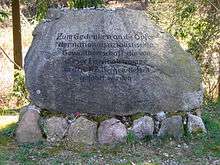
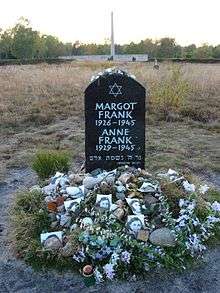
Denazification courts were created by the Allies to try members of the SS and other Nazi organisations. Between 1947 and 1949 these courts initiated proceedings against at least 46 former SS staff at Belsen. Around half of these were discontinued, mostly because the defendants were considered to have been forced to join the SS.[20]:39 Those who were sentenced received prison terms of between four and 36 months or were fined. As the judges decided to count the time the defendants had spent in Allied internment towards the sentence, the terms were considered to have already been fully served.[29]
Only one trial was ever held by a German court for crimes committed at Belsen, at Jena in 1949; the defendant was acquitted. More than 200 other SS members who were at Belsen have been known by name but never had to stand trial.[29] No Wehrmacht soldier was ever put on trial for crimes committed against the inmates of the POW camps at Bergen-Belsen and in the region around it,[27] despite the fact that the International Military Tribunal at Nuremberg had found in 1946 that the treatment of Soviet POWs by the Wehrmacht constituted a war crime.[20]:39
Memorial
The area of the former Bergen-Belsen camp fell into neglect after the burning of the buildings and the closure of the nearby displaced persons' camp in the summer of 1950. The area reverted to heath; few traces of the camp remained. However, as early as May 1945, the British had erected large signs at the former camp site. Ex-prisoners began to set up monuments.[30] A first wooden memorial was built by Jewish DPs in September 1945, followed by one made in stone, dedicated on the first anniversary of the liberation in 1946. On November 2, 1945, a large wooden cross was dedicated as a memorial to the murdered Polish prisoners. Also by the end of 1945 the Soviets had built a memorial at the entrance to the POW cemetery. A memorial to the Italian POWs followed in 1950, but was removed when the bodies were reinterred in a Hamburg cemetery.
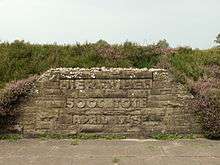
The British military authorities ordered the construction of a permanent memorial in September 1945 after having been lambasted by the press for the desolate state of the camp.[20]:41 In the summer of 1946, a commission presented the design plan, which included the obelisk and memorial walls. The memorial was finally inaugurated in a large ceremony in November 1952, with the participation of Germany's president Theodor Heuss, who called on the Germans never to forget what had happened at Belsen.[20]:41
However, for a long time remembering Bergen-Belsen was not a political priority. Periods of attention were followed by long phases of official neglect. For much of the 1950s, Belsen "was increasingly forgotten as a place of remembrance".[30] Only after 1957, large groups of young people visited the place where Anne Frank had died. Then, after anti-Semitic graffiti was scrawled on the Cologne synagogue over Christmas 1959, German chancellor Konrad Adenauer followed a suggestion by Nahum Goldmann, president of the World Jewish Congress, and for the very first time visited the site of a former concentration camp. In a speech at the Bergen-Belsen memorial, Adenauer assured the Jews still living in Germany that they would have the same respect and security as everyone else.[20]:42 Afterwards, the German public saw the Belsen memorial as primarily a Jewish place of remembrance. Nevertheless, the memorial was redesigned in 1960–61. In 1966, a document centre was opened which offered a permanent exhibition on the persecution of the Jews, with a focus on events in the nearby Netherlands – where Anne Frank and her family had been arrested in 1944. This was complemented by an overview of the history of the Bergen-Belsen camp. This was the first ever permanent exhibit anywhere in Germany on the topic of Nazi crimes.[20]:42 However, there was still no scientific personnel at the site, with only a caretaker as permanent staff. Memorial events were only organized by the survivors themselves.
In October 1979, the president of the European Parliament Simone Veil, herself a survivor of Auschwitz and Bergen-Belsen, came to the memorial for a speech which focused on the Nazi persecution of Roma and Sinti. This was the first time that an official event in Germany acknowledged this aspect of the Nazi era.
In 1985, international attention was focused on Bergen-Belsen when the camp was hastily included in Ronald Reagan's itinerary when he visited West Germany after a controversy about a visit to a cemetery where the interred included members of the Waffen SS (see Bitburg). Shortly before Reagan's visit on May 5, there had been a large memorial event on the occasion of the 40th anniversary of the camp's liberation, which had been attended by German president Richard von Weizsäcker and chancellor Helmut Kohl.[20]:44 In the aftermath of these events, the parliament of Lower Saxony decided to expand the exhibition centre and to hire permanent scientific staff. In 1990, the permanent exhibition was replaced by a new version and a larger document building was opened.
Only in 2000 did the Federal Government of Germany begin to financially support the memorial. Co-financed by the state of Lower Saxony, a complete redesign was planned which was intended to be more in line with contemporary thought on exhibition design.[31] On April 15, 2005, there was a ceremony, commemorating the 60th anniversary of the liberation and many ex-prisoners and ex-liberating troops attended.[32][33] In October 2007, the redesigned memorial site was opened, including a large new Documentation Centre and permanent exhibition on the edge of the newly redefined camp, whose structure and layout can now be traced. Since 2009, the memorial has been receiving funding from the Federal government on an ongoing basis.[34]
The site is open to the public and includes monuments to the dead, including a successor to the wooden cross of 1945, some individual memorial stones and a "House of Silence" for reflection. In addition to the Jewish, Polish and Dutch national memorials, a memorial to eight Turkish citizens who were killed at Belsen was dedicated in December 2012.[35]
Personal accounts
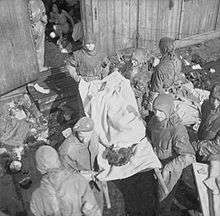
- The British comedian Michael Bentine, who took part in the liberation of the camp, wrote this on his encounter with Belsen:
We were headed for an airstrip outside Celle, a small town, just past Hanover. We had barely cranked to a halt and started to set up the "ops" tent, when the Typhoons thundered into the circuit and broke formation for their approach. As they landed on the hastily repaired strip – a "Jock" [Scottish] doctor raced up to us in his jeep."Got any medical orderlies?" he shouted above the roar of the aircraft engines. "Any K rations or vitaminised chocolate?"
"What's up?" I asked for I could see his face was grey with shock.
"Concentration camp up the road," he said shakily, lighting a cigarette. "It's dreadful – just dreadful." He threw the cigarette away untouched. "I've never seen anything so awful in my life. You just won't believe it 'til you see it – for God's sake come and help them!"
"What's it called?" I asked, reaching for the operations map to mark the concentration camp safely out of the danger area near the bomb line. "Belsen," he said, simply.
Millions of words have been written about these horror camps, many of them by inmates of those unbelievable places. I've tried, without success, to describe it from my own point of view, but the words won't come. To me Belsen was the ultimate blasphemy.
After VE. Day I flew up to Denmark with Kelly, a West Indian pilot who was a close friend. As we climbed over Belsen, we saw the flame-throwing Bren carriers trundling through the camp – burning it to the ground. Our light Bf 108 rocked in the superheated air, as we sped above the curling smoke, and Kelly had the last words on it.
"Thank Christ for that," he said, fervently.
And his words sounded like a benediction.[36]
- Memories of Anne Frank, a book written by Alison Leslie Gold on the recollections of Hannah Goslar, a friend of Anne Frank
- Mervin Willett Gonin DSO wrote about the immediate aftermath to the liberation of Bergen-Belsen in his diary.[37]
- Leslie Hardman, British Army Jewish Chaplain and Rabbi, was the first Jewish Chaplain to enter the camp, two days after its liberation, and published his account in the collective book Belsen in History and Memory.[38]
- Anita Lasker-Wallfisch describes life in Belsen, its liberation and her stay at the displaced persons camp in her autobiography Inherit the Truth.[39]
- Shaul Ladany, who was in the camp as an 8-year-old and later survived the Munich Massacre at the 1972 Summer Olympics recalled:
I saw my father beaten by the SS, and I lost most of my family there... A ransom deal that the Americans attempted saved 2,000 Jews and I was one. I actually went into the gas chamber, but was reprieved. God knows why.[40]
- In his book From Belsen to Buckingham Palace Paul Oppenheimer tells of the events leading up to the internment of his whole family at the camp and their incarceration there between February 1944 and April 1945, when he was aged 14–15.[3] Following publication of the book, Oppenheimer personally talked to many groups and schools about the events he witnessed. This work is now continued by his brother Rudi, who shared the experiences.
- Leonard Webb, British veteran from the liberation of the camp.
- Describing the concentration camp, Major Dick Williams, one of the first British soldiers to enter and liberate the camp, said: "It was an evil, filthy place; a hell on Earth."[41]
- Abel Herzberg wrote the diary Between Two Streams (Dutch: Tweestromenland) during his internment in Bergen-Belsen[42]
- British servicemen Denis Norden and Eric Sykes, who later became popular comedians, stumbled upon the camp in 1945 shortly after liberation; "Appalled, aghast, repelled - it is difficult to find words to express how we felt as we looked upon the degradation of some of the inmates not yet repatriated," Sykes later wrote. "They squatted in their thin, striped uniforms, unmoving bony structures who could have been anywhere between 30 and 60 years old, staring ahead with dead, hopeless eyes and incapable of feeling any relief at their deliverance."[43]
- A number of British artists depicted the aftermath of the liberation of the camp. These included Eric Taylor, Leslie Cole, Doris Zinkeisen, Mary Kessell and Edgar Ainsworth.[44]
- In his 2011 autobiography I Was a Boy in Belsen, Holocaust survivor Tomi Reichental recounts his experiences as a prisoner in the Bergen- Belsen concentration camp.[45]
Media
 |
Vocal
BBC recording from April 20, 1945 of Jewish survivors of the Bergen-Belsen concentration camp singing Hatikvah, today the national anthem of Israel, only five days after their liberation by Allied forces. (The words sung are from the original poem by Naftali Herz Imber.) |
| Problems playing this file? See media help. | |
- The Relief of Belsen (2007 film)
- Frontline: "Memory of the Camps" (May 7, 1985, Season 3, Episode 18), is a 56-minute television documentary that addresses Bergen-Belsen and other Nazi concentration camps[46][47]
- Memorandum (1965 film)
See also
- Holocaust Memorial Day
- Holocaust memorial landscapes in Germany
- List of Nazi-German concentration camps
- Alan Moore (war artist)
References
- 1 2 3 4 "Belsen Military Camp". Retrieved April 3, 2012.
- ↑ Shephard, Ben (2006). After daybreak : the liberation of Belsen, 1945. London: Pimlico. ISBN 978-1844135400.
- 1 2 Oppenheimer, Paul (1996). From Belsen to Buckingham Palace. Nottingham: Quill Press. ISBN 0-9536280-3-5.
- 1 2 "The 11th Armoured Division (Great Britain)", United States Holocaust Memorial Museum.
- ↑ "Bergen-Belsen", United States Holocaust Memorial Museum
- 1 2 3 "POW Camps". Retrieved April 3, 2012.
- 1 2 3 4 "Bergen-Belsen". Retrieved April 3, 2012.
- ↑ Godeke, Monika (ed) (2007). Bergen-Belsen Memorial 2007: Guide to the Exhibition. Scherrer. ISBN 978-3-9811617-3-1.
- 1 2 3 "The Exchange Camp". Retrieved April 3, 2012.
- 1 2 3 4 5 6 7 8 9 10 11 12 13 14 15 16 17 18 19 Knoch, Habbo (ed) (2010). Bergen-Belsen: Wehrmacht POW Camp 1940–1945, Concentration Camp 1943–1945, Displaced Persons Camp 1945–1950. Catalogue of the permanent exhibition. Wallstein. ISBN 978-3-8353-0794-0.
- ↑ Bergen-Belsen, Jewish Virtual Library
- 1 2 "Men's and Women's Camps". Retrieved April 3, 2012.
- ↑ "New research sheds new light on Anne Frank’s last months". AnneFrank.org, 31 March 2015
- 1 2 ""Reception" and dying camps". Retrieved April 3, 2012.
- ↑ "Salonika Jews Sponsor Trial Of Collaborators". Jewishvirtuallibrary.org. September 11, 1945. Retrieved May 3, 2013.
- ↑ Celinscak, Mark (2015). Distance from the Belsen Heap: Allied Forces and the Liberation of a Concentration Camp. Toronto: University of Toronto Press. ISBN 9781442615700.
- ↑ van Straubenzee, Alexander (10 April 2005). "The gate of Hell". The Daily Telegraph. Retrieved 10 April 2014.
- ↑ "The 11th Armoured Division (Great Britain)". Holocaust Encyclopedia. United States Holocaust Memorial Museum. Retrieved 16 April 2014.
- ↑ "Richard Dimbleby, "Liberation of Belsen", BBC News, April 15, 1945". BBC News. April 15, 2005. Retrieved May 3, 2013.
- 1 2 3 4 5 6 7 8 9 Knoch, Habbo (ed) (2010). Bergen-Belsen: Historical Site and Memorial. Stiftung niedersächsische Gedenkstätten. ISBN 978-3-9811617-9-3.
- 1 2 3 "Liberation". Retrieved April 3, 2012.
- ↑ Fletcher, David (2007), "Churchill Crocodile Flamethrower", Volume 136 of New Vanguard, Osprey Publishing, pp. 33 & 47, ISBN 1-84603-083-8
- ↑ Riley, Joanne (1997). Belsen in History and Memory. Taylor & Francis. p. 141. ISBN 0714643238.
- ↑ Riley, Joanne (1998). Belsen: The Liberation of a Concentration Camp. Psychology Press. p. 38. ISBN 0714643238.
- ↑ Television program The Relief Of Belsen, Channel 4 (UK commercial television), 9:00 p.m. to 11:05 p.m. on Monday October 15, 2007.
- 1 2 Riley, Joanne (1997). Belsen in History and Memory. Taylor & Francis. p. 143. ISBN 0714643238.
- 1 2 "The Prosecution of the Perpetrators". Retrieved December 20, 2012.
- 1 2 3 4 5 6 7 "Belsen Trial". Retrieved December 20, 2012.
- 1 2 "German proceedings". Retrieved December 20, 2012.
- 1 2 "Place_of_Remembrance". Retrieved December 21, 2012.
- ↑ "The Holocaust, Viewed Not From Then but From the Here and Now", The New York Times, viewed January 22, 2009
- ↑ Liberation of Belsen commemorated. BBC News, April 15, 2005
- ↑ Horrors of Belsen flood back for survivors, The Telegraph, April 19, 2005
- ↑ "Memorial redesign". Retrieved December 20, 2012.
- ↑ http://www.aa.com.tr/en/world/109752--memorial-in-memory-of-8-turkish-citizens-killed-during-wwii-opens-in-germany
- ↑ Michael Bentine, The Reluctant Jester (Anstey, England: Ulverscroft, 1993), page 281.
- ↑ Scarlata. "Caixa-de-Lata: Banksy – Manifesto". Caixadelata.blogspot.co.uk. Retrieved May 3, 2013.
- ↑ Reilly, Joanne et al. (ed.) (1997). Belsen in History and Memory. London: F. Cass.
- ↑ "Anita Lasker-Wallfisch – Inherit the Truth" (PDF). Retrieved April 30, 2013.
- ↑ "Shaul Ladany Bio, Stats, and Results | Olympics at". Sports-reference.com. Retrieved February 24, 2013.
- ↑ "Tears as day of deliverance from Belsen recalled". The Scotsman. Edinburgh. April 16, 2005. Retrieved February 25, 2013.
- ↑ Eric Sterling, "Between Two Streams: A Diary from Bergen-Belsen Review", A Teacher's Guide to the Holocaust, 1999. Retrieved on 15 February 2015.
- ↑ "How Denis Norden stumbled upon concentration camp horror". BBC News. 23 June 2015. Retrieved 8 September 2015.
- ↑ Jessica Talarico & Gemma Lawrence. "Artists' Response To The Holocaust". Imperial War Museum. Retrieved 16 September 2016.
- ↑ Reichental, Tomi (2011). I Was a Boy in Belsen. Dublin: O'Brien Press Ltd. ISBN 9781847172273.
- ↑ "Memory of the Camps". IMDb. 1985.
- ↑ "Memory of the Camps". TopDocumentaries.com. 1985.
External links
| Wikimedia Commons has media related to Bergen-Belsen concentration camp. |
- Bergen-Belsen Memorial
- The United States' Holocaust Memorial website on Belsen
- Bergen-Belsen Death Camp from Holocaust Survivors and Remembrance Project: "Forget You Not"
- Film footage of Belsen concentration camp and its destruction
- Harold Le Druillenec, from the Channel Islands, was the only British survivor of Bergen Belsen. This link is to his testimony at the Bergen-Belsen trial of his experience there.
- BBC Journalist Richard Dimbleby's original Radio Report from April 15.
- Frontline "Memory of the Camps" (includes footage of liberation of Belsen)
- The Belsen Trial of Joseph Kramer and 44 Others (full trial report)
- "A Personal Account" by Leonard Berney, Lt-Col R.A. T.D.(Rtd)
- Filmed Lecture of First-hand Account of the Liberation of Belsen by Leonard Berney, Lt-Col R.A. T.D.(Rtd)
- Map of the camp, Georgia Institute of Technology
- Pictures of the liberation at Time-Life
- Jewish Calendar and Prayers from Bergen-Belsen
- Bergen Belsen and Beyond Holocaust Diary
